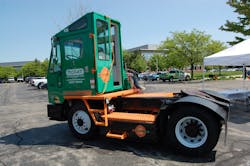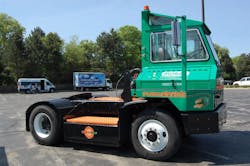Calculating the costs and savings of electric trucks
There’s been a lot of attention paid to the electrification of trucks of late, especially the new Nikola Class 8 concept vehicle, set to be officially unveiled in December this year, trolley-like systems now being tested in the U.S. and Europe, as well as electrified medium-duty models such as the all-electric Fuso eCanter coming the U.S. market in 2017.
[Truck maker Iveco also recently rolled out a super-sleek electrified concept tractor that’s worth a look.]
Many other applications, of course, are getting tested in terms of electrification (light-duty cargo vans come to mind) but as with all of these different electrified models, one question remains constant: Can fleets save enough money to justify the extra up-front costs of switching to electric trucks?
That’s a question Mike Saxton, chief operating officer of Orange EV, deals with an awful lot.
His company builds all-electric terminal tractors or “yard mules” – its latest model is the T-Series all-electric yard mule by the way – and while they don’t accumulate the kinds of long-haul high-speed highway miles Class 8 units do, the same costs/savings pressures apply just as vigorously to all-electric yard mules as to other electrified truck operations.
I got a chance recently to pick his brain about how electric trucks – even all-electric yard mules – can make solid fiscal sense for a fleet over the long term. Here are his thoughts:
Why should a fleet should consider switching to all-electric yard tractors versus diesel ones? What are the benefits?
They switch to save money with a better truck; getting the job done while eliminating diesel fuel and emissions. Fleets can lower total cost of ownership, using existing budgets planned for diesels to buy, and operate them inexpensively due to several key points:
- Even at recent low diesel prices firms have been saving 80% to 90% net on fuel cost after taking into consideration what they pay for electricity to charge an electric truck.
- They also save on maintenance due to having fewer systems on which maintenance is required as the engine, transmission, and emission/exhaust systems are eliminated – replaced by batteries and a maintenance-free brushless induction motor.
- Do you believe diesel prices will stay where they are for much longer? We don’t. Through many different forces, the per-gallon price and true total cost of diesel will continue to increase. And as fuel prices increase, fuel savings associated with going electric increase accordingly. Just run the numbers.
- Together, fuel and maintenance – the “hard-dollar” savings – can today save $20,000 to $25,000 annually at moderate-use sites and up to $60,000 annually at heavier-use sites. Heavier use here means, collectively, more engine hours, which drives maintenance savings and lower fuel consumption. By the way, those are figures based on usage data from trucks deployed now in commercial use.
How does a “heavier use” scenario generate so much more cost savings?
We’ve worked with terminal sites that operate their diesel yard tractors 6,000 hours per year, consuming 2.5 gallons per hour. That’s 15,000 gallons per truck, per year. At $3, $4, and $5 per gallon, the diesel fuel cost alone is $45,000, $60,000, and $75,000, respectively. Then add maintenance on top this, estimated at roughly $10,000 annually. Then those numbers jump to $55,000, $70,000, and $85,000, respectively.
Now, moderate use sites can be half of those figures, but they are all large.Now, those maintenance savings consider Tier 3 and older terminal truck models. When you get to Tier 4 compliant engines, the industry seems only to be starting to understand they have dramatically higher costs, especially in terminal trucks. We don’t have all the numbers yet ourselves but fleets have made it clear that switching to Tier 4 dramatically increases cost, reduces reliability and thereby also reduces the availability of a mission critical asset.
Thus companies must quantify such “true costs” of diesel and measure them against the benefits of electricity, with which they eliminate diesel and the laundry list of associated costs.
Of course, for many fleets, the up-front price they pay for a new vehicle is a major sticking point. What’s the price difference of an all-electric yard mule compared to a diesel-powered one?
In converting to electric, three major cost elements are relevant. As with any vehicle, fleets need to obtain truck and refuel it. So for all-electric models, three key cost components are involved: the truck itself; the re-charging system on the truck; and the electrical infrastructure to support charging.
In our case, we sell and service the first two while the customer provides the third.
So, our baseline pricing includes both truck and standard charging system. Then the customer handles establishing the electrical service out to where they want to park, plug-in, and re-charge their tractors.
That service is usually already available at most sites. Now, at some sites, customers may want faster re-charging, which can increase price. But that’s a good thing, because by getting faster charging, they unlock and realize the higher savings. In other words they get the truck charged and back to work faster, more hours of the day, displacing even more gallons of diesel fuel, on which they save up to 90% by using electricity.
In terms of total cost of ownership (TCO) the “price” is often less, sometimes a lot less. Though all-electric yard tractors may cost more at purchase, they cost much, much less to operate. And, sometimes, they cost less at purchase as well.So, the per-truck cost to purchase a Tier 4 diesel terminal truck can be up to $125,000, depending on whom you are and where you buy them. The per-truck purchase price of our all-electric units start as low as $199,950 and go up to $284,950 per tractor, depending on the fleet’s needs and how we build the trucks to meet those needs.
So, our trucks at purchase can be two times what a diesel-powered one costs at the point of purchase. But when you think about the TCO for each – especially in terms of fuel, maintenance and other items – all of a sudden, pure-electric terminal trucks become very, very compelling price wise.
Turn to the vehicle’s performance characteristics and its “driver environment” for a moment. Are drivers accepting of such all-electric models?
Drivers do like our electric truck much better because it’s cooler – there is no diesel engine under the cab “baking” the driver – and because it offers a smoother ride as there’s no engine vibration, it’s cleaner as there is no diesel exhaust, and quieter as there is no diesel engine or transmission noise.
Let me share this one story. We worked with a driver who’d already started to go deaf and who was missing calls from his dispatcher to grab trailers due the noise of his diesel-powered tractor. This was frustrating for both of them; it also could cost a driver his job. So the first thing he noted when driving our truck was that he could hear the dispatch radio; he didn’t miss his work assignments. It was a big deal for him on a very personal level. So especially now in an environment where recruiting good drivers has become difficult, providing electric yard tractors should help retention. Of course, that would also lower the cost of driver turnover.
Talk about the durability of an electric yard mule. Does it hold up as well under the daily pounding yard tractors endure? Does it have the same or better durability and reliability that a diesel-powered unit offers?
These trucks do take a pounding so that’s a great question. Like with anything new, no matter how much you learn during demonstrations or prototype development, another wave of learning comes once the vehicle is finally in daily commercial use.
We’ve been growing our fleet of commercially deployed trucks for almost a year now and one of the most exciting things for us is that the “core systems” we developed for our electric yard tractor are performing as expected. We’ve also implemented improvements in different areas, too. For example, some sites operated the truck in such a way that we decided to enhance its hydraulic system capacity to do things like increase fifth wheel lifting speed.
Finally, many feel that with the relatively low diesel fuel prices we’re experiencing today that electric trucks, much less yard tractors, just don’t make enough fiscal sense right now. What’s your take?
The shift to electric is happening faster than most fleets realize both in what the technology can accomplish and in light of new and increasingly stricter emission standards. For example, California just passed SB 32, which paves the way for continued emissions reductions – specifically for “greenhouse” gases (GHG) – to some 40% below 1990s level by 2030. The Environmental Protection Agency (EPA) also just passed its new rules enacting similar emissions reductions.
In short, the U.S. isn’t turning back from truck emission standards – and it’s implementing new ones for GHGs now as well. Exhaust emission control rules add new game-changing costs to fleet operations and those higher costs are already increasing the true “total cost” of diesel-powered machines – even if fleets don’t realize it.
Some fleet also understand that this shift is occurring faster than most realize; thus it makes financial sense to switch to electricity now, for those who wait too long may find their operations no longer viable – and at a time when incentives may no longer available.
Remember, too, that late adopters will have older, dirtier trucks and may be not be allowed to operate at some of their sites – remember there are residential neighborhoods near which many must operate – and on which they’ll have to spend more to maintain. Those firms keeping diesels around too long may find themselves at a competitive disadvantage.
That’s why we believe shifting to electricity will drive a new wave of winners and losers in transportation, logistics, and more specifically in our case, fleets managing container handling operations.
In the end, is electricity a good propulsion choice for most trucking fleets? Probably not, though time will only tell as the technology keeps improving.
Yet as Saxton’s commentary points out, there are many applications where switching to electric power today can make good monetary and performance sense.
It’ll be up to fleets in those applications to connect the available dots to see if electrical propulsion will work for their specific operation.


